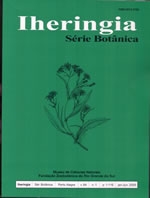Seed bank from a relictic of Espinal (Córdoba, Argentina).
Keywords:
Native seed, exotic seed, transient seed bank, persistent seed bank.Abstract
The aims of this study were to describe the composition of seed bank from a relictic area of Espinal, to classify the seed bank according to the persistence of the seeds within, to compare between the seed bank and established vegetation of the area and to present pictures of the seeds that were found. According to our results, there are 44 species in the seed bank, representing 18 families. The best represented families are Poaceae with 12 species, and Asteraceae with seven species. When the comparison between the seed bank and established vegetation was carried out, we found that the occurrence of exotic species was great in the
prior, being Chenopodium album the most frequent species and it also has the highest density. We also found 19 species in the transient seed bank, 14 species in the short-term persistent seed bank and 11 in the long-term persistent seed bank. The majority of species that comprise the persistent banks are native. The high frequency of native species in the persistent banks could be an important factor during the regeneration of the area.
Downloads
References
BAKKER, J.; POSCHLOD, P.; STRYKSTRA, R.; BEKKER, R.; THOMPSON, K. 1996. Seed banks and seed dispersal: important
topics in restoration ecology. Acta Botanica Neerlandica, v. 45,
n. 4, p. 461-490.
BERTONATTI, C.; CORCUERA, J. 2001. Situación Ambiental Argentina 2000. Buenos Aires. Fundación Vida Silvestre. 436p.
BIANCO, C.; NUÑEZ, C.; KRAUS, T. 2000. Identificación de frutos y semillas de las principales malezas del centro de Argentina. Río Cuarto. Fundación Universidad Nacional de Río Cuarto. 142p.
ECHEVERRÍA, J.; COLLADO, A. 2001. Evaluación del ritmo de invasión del Chañar en San Luis mediante teledetección y SIG. In: PRIMER CONGRESO NACIONAL Y QUINTA JORNADA REGIONAL SOBRE MANEJO DE PASTIZALES NATURALES, Santa Fe. 2001. Acta de Resúmenes, p. 39-40.
HOLM, L.; PLUCKNETT, O.; PANCHO, J.; J. HERBERGER. 1977. The world’s worst weeds: distribution and biology. East-West Center. University Press of Hawaii. 609p.
LEWIS, J. 1973. Longevity of crop and weed seeds: Survival after 20 years. Weed research, v. 13, p. 179-191.
MALONE, C. R. 1967. A rapid method for enumeration of viable seeds en soil. Weeds, v.15, p. 381-382.
MARAÑÓN, T. 1995. Ecología de los bancos de semilla en el suelo: Una revisión de estudios españoles. Pastos, v. 25, n. 1, p. 3-25.
MARTIN, A.C.; BARKLEY, W.D. 1973. Seed identification manual. Berkeley. Los Angeles and London. University of California Press. 221p.
MORELLO, J., MARCHETTI, B.; P. CICHERO. 1991. Análisis de la situación del ambiente: Argentina. In: LA SITUACIÓN AMBIENTAL EN AMÉRICA LATINA. Buenos Aires. Konrad-Adenauer-Stiftung. 579p.
PERALTA I.; ROSSI, B. 1997. Guía para el reconocimiento de especies del banco de semillas de la Reserva de Biósfera de Ñacuñán (Mendoza, Argentina). Boletín de Extensión Científica, v. 3, p. 1-24.
PETETIN, C.; MOLINARI, E. 1982. Reconocimiento de semillas de malezas. Buenos Aires. INTA. 146p. (Colección científica del INTA)
RAINER CINTI, R. 1998. Había una vez un bosque. Vida silvestre, v. 62, p. 4 -11.
THOMPSON, K. 1992. Ecology of soil seed bank. In: FENNER, M. (Ed.). Seeds. La ecology of regeneration in plant communities. C.A.B. International. Wallingford, UK. 373p.
______. 1993. Persistence in soil. In: HENDRY, G.; GRIME, J. (Eds.). Methods in comparative plant ecology. A laboratory manual. London. Chapman & Hall. 252p.
VISCHI, N.; OGGERO, A. (Eds.). 2002. Bosque Autóctono el Espinal: un área protegida. Río Cuarto. Universidad Nacional de Río Cuarto. 36p.







